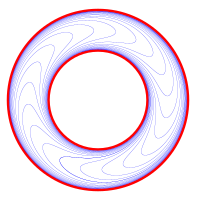
Back Foliació Catalan Blätterung German Foliación Spanish برگسازی Persian Feuilletage French Teoria delle foliazioni Italian 엽층 Korean Foliatie (differentiaaltopologie) Dutch Слоение Russian Шарування Ukrainian


In mathematics (differential geometry), a foliation is an equivalence relation on an n-manifold, the equivalence classes being connected, injectively immersed submanifolds, all of the same dimension p, modeled on the decomposition of the real coordinate space Rn into the cosets x + Rp of the standardly embedded subspace Rp. The equivalence classes are called the leaves of the foliation.[1] If the manifold and/or the submanifolds are required to have a piecewise-linear, differentiable (of class Cr), or analytic structure then one defines piecewise-linear, differentiable, or analytic foliations, respectively. In the most important case of differentiable foliation of class Cr it is usually understood that r ≥ 1 (otherwise, C0 is a topological foliation).[2] The number p (the dimension of the leaves) is called the dimension of the foliation and q = n − p is called its codimension.
In some papers on general relativity by mathematical physicists, the term foliation (or slicing) is used to describe a situation where the relevant Lorentz manifold (a (p+1)-dimensional spacetime) has been decomposed into hypersurfaces of dimension p, specified as the level sets of a real-valued smooth function (scalar field) whose gradient is everywhere non-zero; this smooth function is moreover usually assumed to be a time function, meaning that its gradient is everywhere time-like, so that its level-sets are all space-like hypersurfaces. In deference to standard mathematical terminology, these hypersurface are often called the leaves (or sometimes slices) of the foliation.[3] Note that while this situation does constitute a codimension-1 foliation in the standard mathematical sense, examples of this type are actually globally trivial; while the leaves of a (mathematical) codimension-1 foliation are always locally the level sets of a function, they generally cannot be expressed this way globally,[4][5] as a leaf may pass through a local-trivializing chart infinitely many times, and the holonomy around a leaf may also obstruct the existence of a globally-consistent defining functions for the leaves. For example, while the 3-sphere has a famous codimension-1 foliation discovered by Reeb, a codimension-1 foliation of a closed manifold cannot be given by the level sets of a smooth function, since a smooth function on a closed manifold necessarily has critical points at its maxima and minima.
- ^ Candel & Conlon 2000, p. 5
- ^ Anosov 2001
- ^ Gourgoulhon 2012, p. 56
- ^ Reeb, G. (1959), "Remarques sur les structures feuilletées" (PDF), Bull. Soc. Math. France, 87: 445–450, doi:10.24033/bsmf.1539, Zbl 0122.41603
- ^ Cite error: The named reference
Lawsonwas invoked but never defined (see the help page).